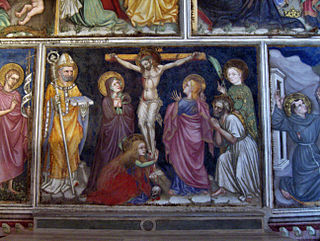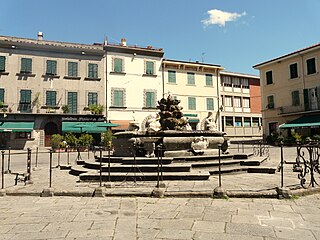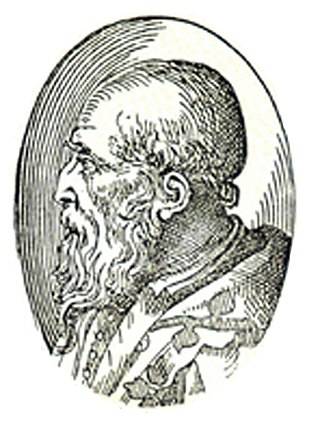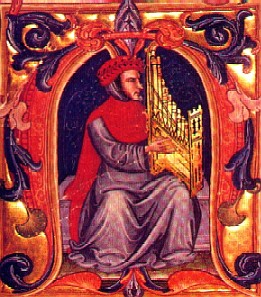
The House of Colonna, also known as Sciarrillo or Sciarra, is an Italian noble family, forming part of the papal nobility. It was powerful in medieval and Renaissance Rome, supplying one pope and many other church and political leaders. The family is notable for its bitter feud with the Orsini family over influence in Rome, until it was stopped by papal bull in 1511. In 1571, the heads of both families married nieces of Pope Sixtus V. Thereafter, historians recorded that "no peace had been concluded between the princes of Christendom, in which they had not been included by name".

Year 1324 (MCCCXXIV) was a leap year starting on Sunday of the Julian calendar.

Jacobus de Voragine was an Italian chronicler and archbishop of Genoa. He was the author, or more accurately the compiler, of the Golden Legend, a collection of the legendary lives of the greater saints of the medieval church that was one of the most popular religious works of the Middle Ages.

Jacopo Sannazaro was an Italian poet, humanist, member and head of the Accademia Pontaniana from Naples.

Guarino Veronese or Guarino da Verona was an Italian classical scholar, humanist, and translator of ancient Greek texts during the Renaissance. In the republics of Florence and Venice he studied under Manuel Chrysoloras, renowned professor of Greek and ambassador of the Byzantine emperor Manuel II Palaiologos, the first scholar to hold such course in medieval Italy.

ManuelChrysoloras was a Byzantine Greek classical scholar, humanist, philosopher, professor, and translator of ancient Greek texts during the Renaissance. Serving as the ambassador for the Byzantine emperor Manuel II Palaiologos in medieval Italy, he became a renowned teacher of Greek literature and history in the republics of Florence and Venice, and today he's widely regarded as a pioneer in the introduction of ancient Greek literature to Western Europe during the Late Middle Ages.

Altichiero da Zevio, also called Aldighieri da Zevio, was an Italian painter much influenced by Giotto, certainly through knowledge of the frescoes in the Cappella degli Scrovegni in Padua and quite possibly through having been trained in Florence by one of Giotto's pupils. Altichiero worked in Verona and Padua. Works by him survive in the church of Sant'Anastasia in Verona and in the Cappella di S Felice in the basilica of Sant'Antonio and the Oratorio di San Giorgio in Padua. His stature was compromised for a long time through his supposed collaboration with a certain Jacopo Avanzo or Avanzi, but study of the documents and historiography demonstrated Atichiero's authorship of the frescoes in both the Santo and the Oratorio di San Giorgio. It has been argued that the hand of an assistant can be seen in some early scenes in the Santo – although it was certainly Altichiero who was paid to decorate the chapel, and he received 792 ducats in the summer of 1379.

Marco Girolamo Vida or Marcus Hieronymus Vida was an Italian humanist, bishop and important poet in Christian Latin literature.

Fivizzano is a comune in the province of Massa and Carrara, Tuscany, central Italy.

Italian literature is written in the Italian language, particularly within Italy. It may also refer to literature written by Italians or in other languages spoken in Italy, often languages that are closely related to modern Italian, including regional varieties and vernacular dialects.

Michele Sanmicheli, sometimes also transcribed as Sammicheli, Sanmichele or Sammichele, was an Italian architect and urban planner who was a citizen of the Republic of Venice.

The Basilica of Saint Augustine in Camp Martius, commonly known as Basilica of Saint Augustine is a Roman Catholic minor basilica in Rome. The titular church is dedicated to Saint Augustine of Hippo and serves as the motherhouse of the Augustinian Order.

The Trecento was a period of vigorous activity in Italy in the arts, including painting, architecture, literature, and music. The music of the Trecento paralleled the achievements in the other arts in many ways, for example, in pioneering new forms of expression, especially in secular song in the vernacular language, Italian. In these regards, the music of the Trecento may seem more to be a Renaissance phenomenon; however, the predominant musical language was more closely related to that of the late Middle Ages, and musicologists generally classify the Trecento as the end of the medieval era. Trecento means "three hundred" in Italian but is usually used to refer to the 1300s. However, the greatest flowering of music in the Trecento happened late in the century, and the period is usually extended to include music up to around 1420.

Antonio "Zacara" da Teramo was an Italian composer, singer, and papal secretary of the late Trecento and early 15th century. He was one of the most active Italian composers around 1400, and his style bridged the periods of the Trecento, ars subtilior, and beginnings of the musical Renaissance.

Francesco Barbaro (1390–1454) was an Italian politician, diplomat, and humanist from Venice and a member of the patrician Barbaro family. He is interred in the Church of the Frari, Venice.

Jacopo d'Avanzi was an Italian painter of the Renaissance period. He is also known as Jacopo Avanzi or Jacopo de Avanzi, although apparently often confused with other artists, including Jacopo de' Bavozi and the Vicentine Avanzo.

Giacomo or Jacopo d'Angelo, better known by his Latin name Jacobus Angelus, was an Italian classical scholar, humanist, and translator of ancient Greek texts during the Renaissance. Named for the village of Scarperia in the Mugello in the Republic of Florence, he traveled to Venice where the Byzantine emperor Manuel II Palaiologos' ambassador Manuel Chrysoloras was teaching Greek, the first scholar to hold such course in medieval Italy.

Pistoia Cathedral, or Cathedral of Saint Zeno is the main religious building of Pistoia, Tuscany, central Italy, located in the Piazza del Duomo in the centre of the city. It is the seat of the Bishop of Pistoia and is dedicated to Saint Zeno of Verona.

The San Michele Oratory or Oratory of San Michele is an oratory chapel in Padova, Italy. The interior is painted with a cycle of frescoes on the life of the Virgin Mary by Jacopo da Verona.



















